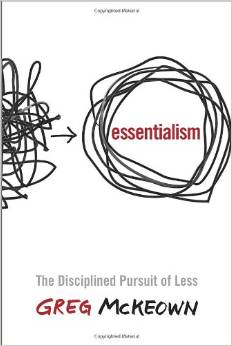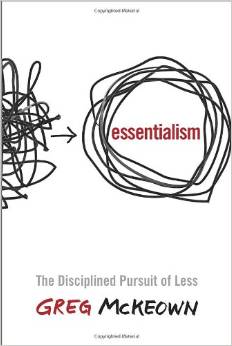Essentialism-The Disciplined Pursuit of Less-Applied to Investing
It’s not often that you come across a book with a revolutionary, perspective-altering theme. Essentialism by Greg McKeown is that book.
“Essentialism isn’t about getting more done in less time. It’s about getting only the right things done.” book jacket, Essentialism.
My motto from the start; set a goal, work hard, experience results, work harder, and keep going until you get the desired outcome. (Fail and get back up again and again.) I never considered the possibility that many of my efforts might not be leading to my desired outcome.
McKeown transforms the idea of “focus and goal setting”. He posits that in order to work at the highest level, on the projects that are absolutely essential, one must do less and better in every area of our lives.
The difficulty of this pursuit is; “What is essential?“. If you’re stuck figuring out what’s essential and what isn’t, McKeown offers tests to help readers separate what might be essential from what is truly essential:
“If we could be truly excellent at one thing, what would it be?”
This is a more difficult question than meets the eye. For example, I want to “teach essential, research supported investment strategies“. This sounds okay, but in truth, it’s a bit vague; teach in what venue, to whom, and how will I know if I”m succeeding?
Consider this statement of purpose by Brad Pitt (actor and social entrepreneur) for the organization he started after Hurricane Katrina called “Make it Right”. “To build 150 affordable green homes for families living in the Lower 9th Ward“. This statement is clear, succinct, and includes an attainable, measurable outcome.
Essentialism challenges one to find the core, the essence of your life, which guides your purpose and helps to drive your life direction.
As McKeown admits, this is a difficult task. I concur, as I struggle to hone the essence of my true course. He’s asking readers not for a laundry list of “ideas” of what you’re about, but an acknowledgement of your “single highest point of contribution”.
The book continues to focus by clarifying the power of saying “no” to activities and people which don’t coincide with your mission. It’s not new that if we take on too much, we’re not doing well at anything. Yet, the act of saying no violates the “social convention” of service to the tribe and fear of disregard by others. McKeown states that saying no or even thinking of declining a request makes us physically ill.
“Nonessentialists apply implicit or unspoken criteria to the decisions they make in both their personal and their professional lives.” Essentialism, page 105. (For example, if my manager asks me to do something, I must do it.)
“If it isn’t a clear yes, then it’s a clear no.” Essentialism, page 109.
How to Apply Essentialism Criteria to Decision Making
How do you decide what is your essential purpose? McKeown recommends drilling down by asking these three questions:
1. What am I deeply passionate about?
2. What taps my talent?
3. What meets a significant need in the world?
My reworked statement of purpose: “I teach savvy professionals to invest and build wealth for a rich future”.
Is this any better? Maybe. As McKeown states, its not easy to define your life purpose… I’ll keep working on it.
Essentialism Investing
Investing is replete with the investing research. Surprising isn’t it? Of course not.
With more mutual and exchange traded funds than actual stocks to purchase, it’s difficult to see the parallel between investing and essentialism.
Shouldn’t the best investment portfolio require extensive research, stock and bond selection, consideration of commodities and alternative options?
No.
Essential Investing Strategy
“It’s never taken less effort or expense to invest well.” “Winning Made Simple”, by Pat Regnier, Money, (Jan/Feb, 2014), p. 56
Although I’m a proponent of a simple asset classes index fund investing strategy (aligned with your risk tolerance), there are ways to beat the market:
- Be a “high frequency trader” with a computer program who can make a stock trade in 7/10,000ths of a second.
- Trade on insider information.
- Subscribe to Bloomberg online news service ($20,000 per year) and beat out the rest of the investing community.
The individual investor can’t employ these market beating strategies. And, if you look at the long term returns of most of the professional money managers, they can’t beat the returns of an index fund investing approach even with access to expensive investing tools and databases.
The essentialism investing strategy is straightforward with clear purpose. Don’t attempt to Beat the Pros, but match the markets. You’ll be ahead of most investors.
Index Fund Investing versus Active Management
I comb the investing research, so you don’t need to.
And in this 2014 study, The Case for Index Fund Investing, by Philips, Kinniry, Schlanger, and Hirt, the popular thesis that index fund investing beats active management is once again supported in the majority of cases.
For a quick review, indexing is an investment strategy that strives to mirror the returns of a specific market index, such as the S & P 500. The study referenced above compares the performance statistics of actively managed (stock and/or bond picking by managers) mutual funds with that of comparable passive or index funds.
The study found that the low cost index funds had a greater probability of outperforming higher fee actively managed funds in spite of the fact that index funds normally underperform their respective benchmarks.
For example, 68 percent of the actively managed U.S. large-cap value equity funds underperformed their benchmarks for the 10 year period ending December 31, 2013. Although less reliable, most index fund approaches also outperformed over shorter time periods as well.
You can read more about how to apply a simple index fund investing approach in this free micro book, How to Invest and Ouperform Most Active Fund Managers.
How Would Greg McKeown Invest?
Essentialism in investing would be a focused approach using a research driven efficient strategy. I expect Greg McKeown would invest using asset classes in line with his risk tolerance.
Obviously, I have no knowledge of how McKeown invests, yet extrapolating essentialism thinking into the investing arena, I can’t imagine him using any other approach. It’s elegant, efficient, and generally offers superior performance over that of active mutual funds. Additionally, an index fund investing approach requires minimal excess effort (after the initial set up) in order to achieve market matching returns.
Action Steps
1. You must read Essentialism, it will improve your wealth in life (and maybe even financial wealth as well).
2. Take time to think, play, and live. There’s more to life than work and money.
The beauty of the essentialism idea is that if you’re focused on what really matters, and judicious about eliminating the superfluous, then there’s sufficient time for play, inspiration and thought.
What is your essential purpose?



